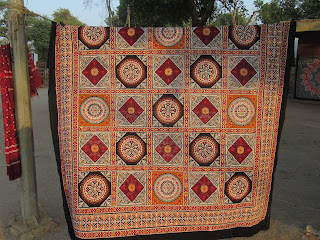Ranikot Fort
We drove out of Sehwan along thr main roa. It hugs a bit of ground betweensome foothills and the vast flat plain. Along side the road and paraleell to it runs a railway line, halfway up the slope of the hill. It would have been easier to build it across the plain but it is subject to flooding. So dispite the extra cost and time to build the line, it runs across the face of th slope. Most railways and roads are built on embankments for much the same reason. It allows evacuation of people and delivery of aid in times of flood.A view of the walls stretching up the hill to the east.
The break in the wall for the wadi. The road crosses through the wall just here across a sandy wadi bottom. There are holes in the wall to allow beams to be pushed in to form a fence and a wooden gate. Water can pass through but not people or livestck without permission.
A view of the climb up the east wall.
A view of the west wall from part way up the east wall. I choose to walk up the east side despite the number of steps looking less and the radient ws not so steep. It might be an easier walk but in the morning, the photos looking back at the east wall would have been into the sun so not wuite so good.
It would have been easy to walk just a little further to the next tower or hilltop but we got to the top of the first hill to the east and took in the view. But we returned to the car in the wadi. Whilst I had been ascending the wall with my guide, the driver had been checking with the road crew on the condition of the road going further into the mountans.
They would be moving onto to repair this section a little later but were positioning aggregate ready for the next phase. The fact that they were here meant that the road was in dire need of repair. It was rough, often just a gravel track but it was negotiable. But neither the guide nor th driver had been this far before. There was a fort further into the mountains and we were so close and had time that we couldn't miss the opportunity to explore.
The fort from a distance across a wadi.The 'road', just a gravel track. There had been a tarmac surfsce but most of it had crumbled away.
A closer view of the front facade.
The protections in front of the main gate.
The second gate. In the archway, there is a doorway that leds to a flight of stairs that give access to the tops of the walls. Visitors can walk all the way around the top.
A view of the entrance from the corner bastion. The walls are in good condition after rebuilding by the Endowment Trust Fund. However, there is little to see inside the fort itself. There are some recently built stone buildings including toilets but no original structures.
When we ot back to the wadi opening through the wall, the road crew had been busy. They had laid a couple of hundred metres of new tarmac. Unfortunatly the tarmacing machine was two lanes wide and we had to wait until it had finished the road through a cutting before we could bounce across some desert to get around it and back to the main road.
The next section of road to be laid on freshly rolled aggregate.
We drove on towards Hyderabad and had lunch en route. We stopped in Hala to see some local crafts for which the area is known for. First was a bed making workshop. The bed legs are turned and painted in pretty colours.
A partially assembled bed.
A frames used to make a rocking bed.
The carpentry workshop that creates the turned wood.

The final touches, giving it a coat of resin and turning it by hand with a bow and scraping off the resin to leave a bright shiny and durable surface.
Next stop was a pottery with baths to mix the clay to a consistent texture...
...and making it into whatever shape is required.
After firing, the skill of the designer is paramount to create the patterns, all by hand and eye.
Other finished items.
Next was a fabric printing workshop. The fabric comes in as plain fabric. The artisans here create their own natural pigments from plants, no chemicals are used. to create the colours
Small carefully carved wood blocks are used to transfer one colour of the pattern onto the fabric. More complicted pattrns like this one can take 17 separate sessions to complete.
Some plain fabric and at the top of the photo are some of the small wood blocks, and some cast blocks used to transfer the pattern onto the cloth.
Last stop of the day before we reached our hotel in hyderabad was the tomb of Shah Abdul Latif Bhittai (1689 - 1752). He was a Sufi mystic and poet, widely considered to be the greatest poet who wrote in the Sindhi language. The statue is located in a public park overlooking a lake.

































No comments:
Post a Comment